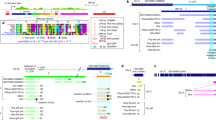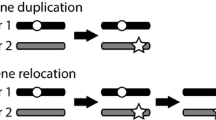Abstract
Molecular evolution and divergence of paralogous tandem heterochromatic repeats Stellate and Su(Ste) located on the X and Y chromosomes, respectively, are discussed. These repeats appear to emerge as a result of amplification of a unique autosomal euchromatic gene encoding the regulatory β-subunit of the CK2 protein kinase. The autosomal gene and the clusters of heterochromatic repeats are transcribed in testes. A high level of the Stellate expression leads to partial male sterility and abnormal meiosis. The Stellate expression and its adverse effects are suppressed by homologous Su(Ste) repeats. In genome evolution, the open reading frames (ORF) of Stellate and Su(Ste) putative ancestor were maintained by translational selection. Then the coding Su(Ste) function has been damaged and switched to a new one resulting in antisense Su(Ste) transcription and silencing of theStellategenes. Symmetrical (sense and antisense) Su(Ste) transcription causes the formation of a double-strand RNA, which by interference (selective elimination of the homologous gene expression) suppresses the Stellate genes. The biological significance and the driving forces of evolution of the species-specific balanced interaction of Stellateand Su(Ste) repeats remain mysterious.
Similar content being viewed by others
REFERENCES
Liao, D., Molecular Evolution '99: Concerted Evolution: Molecular Mechanism and Biological Implications, Am. J. Hum. Genet., 1999, vol. 64, pp. 24-30.
Hardy, R.W., Lindsley, D.L., Livak, K.J., et al., Cytogenetic Analysis of a Segment of the Y Chromosome of Drosophila melanogaster, Genetics, 1984, vol. 107, pp. 591-610.
Livak, K.J., Organization and Mapping of a Sequence of Drosophila melanogaster X and Y Chromosomes That Is Transcribed during Spermatogenesis, Genetics, 1984, vol. 107, pp. 611-634.
Livak, K.J., Detailed Structure of the Drosophila melanogaster Stellate Genes and Their Transcripts, Genetics, 1990, vol. 124, pp. 303-316.
Bozzetti, M., Massari, S., Finelli, P., et al., The Ste Locus, a Component of the Parasitic Cry-Ste System of Drosophila melanogaster, Encodes a Protein That Forms Crystals in Primary Spermatocytes and Mimics Properties of the β Subunit of Casein Kinase 2, Proc. Natl. Acad. Sci. USA, 1995, vol. 92, pp. 6067-6071.
Hurst, L.D., Further Evidence Consistent with Stellate's Involvement in Meiotic Drive, Genetics, 1996, vol. 142, pp. 641-643.
Hurst, L.D. and Smith, N.G.C., The Evolution of Concerted Evolution, Proc. R. Soc. London, B, 1998, vol. 265, pp. 121-127.
Kalmykova, A.I., Dobritsa, A.A., and Gvozdev, V.A., The Su(Ste) Repeat in the Y Chromosome and βCK2tes Gene Encode Predicted Isoforms of Regulatory β-Subunit of Protein Kinase CK2 in Drosophila melanogaster, FEBS Lett., 1997, vol. 416, pp. 164-166.
Palumbo, G., Berloco, M., Fanti, L., et al., Interaction Systems between Heterochromatin and Euchromatin in Drosophila melanogaster, Genetica (The Hague), 1994, vol. 94, pp. 267-274.
Shevelyov, Y., Copies of a Stellate Gene Variant Are Located in the X Heterochromatin of Drosophila melanogaster and Are Probably Expressed, Genetics, 1992, vol. 132, pp. 1033-1037.
Tulin, A.V., Kogan, G.L., Filipp, D., et al., Heterochromatic Stellate Gene Cluster in Drosophila melanogaster: Structure and Molecular Evolution, Genetics, 1997, vol. 146, pp. 253-262.
Zhimulev, I.F., Polytene Chromosomes, Heterochromatin and Position Effect Variegation, Adv. Genet., 1998, vol. 37, pp. 1-566.
Kalmykova, A.I., Shevelyov, Y.Y., Dobritsa, A.A., and Gvozdev, V.A., Acquisition and Amplification of a Testis-Expressed Autosomal Gene, SSL, by the Drosophila Y Chromosome, Proc. Natl. Acad. Sci. USA, 1997, vol. 94, pp. 6927-6302.
Charlesworth, B., The Evolution of Chromosomal Sex Determination and Dosage Compensation, Curr. Biol., 1996, vol. 6, pp. 149-162.
Aravin, A.A., Naumova, N.M., Tulin, A.V., et al., Double-Stranded RNA-Mediated Silencing of Genomic Tandem Repeats and Transposable Elements in the D. melanogaster Germline, Curr. Biol., 2001, vol. 11, pp. 1017-1027.
Sharp, P.A., RNA Interference-2001, Genes. Dev., 2001, vol. 15, pp. 485-490.
Fire, A., Xu, S., Montgomery, M.K., et al., Potent and Specific Genetic Interference by Double-Stranded RNA in Caenorhabditis elegans, Nature, 1998, vol. 391, pp. 806-811.
Saxena, A., Carney, M., Bruley, M., and Glover, C.V.C., Characterization of Genes Encoding the α and β Subunits of Drosophila Casein Kinase II, Genetics, 1989, vol. 122, p. S25.
Balakireva, M.D., Shevelyov, Yu.Ya., Nurminsky, D.I., et al., Structural Organization and Diversification of Y-Linked Sequences Comprising Su(Ste) Genes in Drosophila melanogaster, Nucleic Acids Res., 1992, vol. 20, pp. 3731-3736.
Kalmykova, A.I., Dobritsa, A.A., and Gvozdev, V.A., Su(Ste) Diverged Tandem Repeats in the Y Chromosome of Drosophila melanogaster Are Transcribed and Variously Processed, Genetics, 1998, vol. 148, pp. 243-249.
Kogan, G.L., Epstein, V.N., Aravin, A.A., and Gvozdev, V.A., Molecular Evolution of Two Paralogous Tandemly Repeated Heterochromatic Gene Clusters Linked to the X and Y Chromosomes of Drosophila melanogaster, Mol. Biol. Evol., 2000, vol. 17, pp. 697-702.
Chantalat, L., Leroy, D., Filhol, O., et al., Crystal Structure of the Human Protein Kinase CK2 Regulatory Subunit Reveals Its Zinc Finger-Mediated Dimerization, EMBO J., 1999, vol. 18, pp. 2930-2940.
Sharp, P.M. and Matassi, G., Codon Usage and Genome Evolution, Curr. Opin. Genet. Dev., 1994, vol. 4, pp. 851-860.
Akashi, H., Codon Bias Evolution in Drosophila: Population Genetics of Mutation-Selection Drift, Gene, 1997, vol. 205, pp. 269-278.
Powell, J.R. and Moriyama, E.N., Evolution of Codon Usage Bias in Drosophila, Proc. Natl. Acad. Sci. USA, 1997, vol. 94, pp. 7784-7790.
McKee, B. and Satter, M.T., Structure of the Y-Chromosomal Su(Ste) Locus in Drosophila melanogaster and Evidence for Localized Recombination among Repeats, Genetics, 1996, vol. 142, pp. 149-161.
Palumbo, G., Bonaccorsi, S., Robbins, L.G., and Pimpinelli, S., Genetic Analysis of Stellate Elements of Drosophila melanogaster, Genetics, 1994, vol. 138, pp. 1181-1197.
Robbinns, L. and Belloni, M., Who Causes Meiotic Drive—Ste + or cry -?, 17th Eur. Drosophila Res. Conf., 2001, Edinburgh, 2001, p. 39.
Russo, C.A.M., Takezaki, N., and Nei, M., Molecular Phylogeny and Divergence Times of Drosophilid Species, Mol. Biol. Evol., 1995, vol. 12, pp. 391-404.
Danilevskaya, O.N., Kurenova, E.V., Pavlova, M.N., et al., He-T Family DNA Sequences in the Y Chromosome of Drosophila melanogaster Share Homology with the X-Linked Stellate Genes, Chromosoma, 1991, vol. 100, pp. 118-124.
Tuschl, T., Zamore, P.D., Lehmann, R., et al., Targeted mRNA Degradation by Double-Stranded RNA in Vitro, Genes Dev., 1999, vol. 13, pp. 3191-3197.
Tabara, H., Sarkissian, M., Kelly, W.G., et al., The rde-1 Gene, RNA Interference, and Transposon Silencing in C. elegans, Cell (Cambridge, Mass.), 1999, vol. 99, pp. 123-132.
Schmidt, A., Palumbo, G., Bozetti, M.P., et al., Genetic and Molecular Characterization of Sting, a Gene Involved in Crystal Formation and Meiotic Drive in the Male Germ Line of Drosophila melanogaster, Genetics, 1989, vol. 151, pp. 749-760.
Ketting, R.F., Haverkamp, T.H., van Luenen, H.G., and Plasterk, R.H., Mut-7 of C. elegans, Required for Transposon Silencing and RNA Interference, Is a Homolog of Werner Syndrome Helicase and RNase D, Cell (Cambridge, Mass.), 1999, vol. 99, pp. 133-141.
Knight, S.W. and Bass, B.L., A Role for the RNase III Enzyme DCRI in RNA Interference and Germ Line Development in C. elegans, Science, 2001, vol. 293, pp. 2269-2271.
Hutvagner, G., McLachlan, J., Pasquinelli, A.E., et al., A Cellular Function for the RNA-Interference Enzyme Dicer in the Maturation of the let-7 Small Temporal RNA, Science, 2001, vol. 293, pp. 834-838.
Thompson-Steward, D., Karpen, G.H., and Spradling, A.C., A Transposable Element Can Drive the Concerted Evolution of Tandemly Repetitious DNA, Proc. Natl. Acad. Sci. USA, 1994, vol. 91, pp. 9042-9046.
Spradling, A.C., Transposable Elements and the Evolution of Heterochromatin, in Molecular Evolution of Physiological Process, Rockefeller Univ. Press, 1994, pp. 76-83.
Williams, S.M., Furiner, G.R., Fuog, E., and Strobeck, C., Evolution of Ribosomal DNA Spacers of Drosophila melanogaster: Different Patterns of Variation on X and Y Chromosomes, Genetics, 1987, vol. 116, pp. 225-232.
Parniske, M., Hammond-Kosack, K.E., Goldstein, C., et al., Novel Disease Resistance Specificities Result from Sequence Exchange between Tandemly Repeated Genes at the Cf-4/9 Locus of Tomato, Cell (Cambridge, Mass.), 1997, vol. 91, pp. 821-832.
Nassif, N. and Engels, W., DNA Homology Requirements for Mitotic Gap Repair in Drosophila, Proc. Natl. Acad. Sci. USA, 1993, vol. 90, pp. 1262-1266.
Lahn, B.T., Pearson, N.M., and Jegalian, K., The Human Y Chromosome in the Light of Evolution, Nat. Rev. Genet., 2001, vol. 2, pp. 207-216.
Lahn, B.T. and Page, D.C., Four Evolutionary Strata on the Human X Chromosome, Science, 1999, vol. 286, pp. 964-967.
Author information
Authors and Affiliations
Rights and permissions
About this article
Cite this article
Kogan, G.L., Gvozdev, V.A. Molecular Evolution of Tandemly Repeated Heterochromatic Gene Clusters Involving a Switch of Their Function in the Genome of Drosophila melanogaster. Russian Journal of Genetics 38, 586–593 (2002). https://doi.org/10.1023/A:1016075414124
Issue Date:
DOI: https://doi.org/10.1023/A:1016075414124




